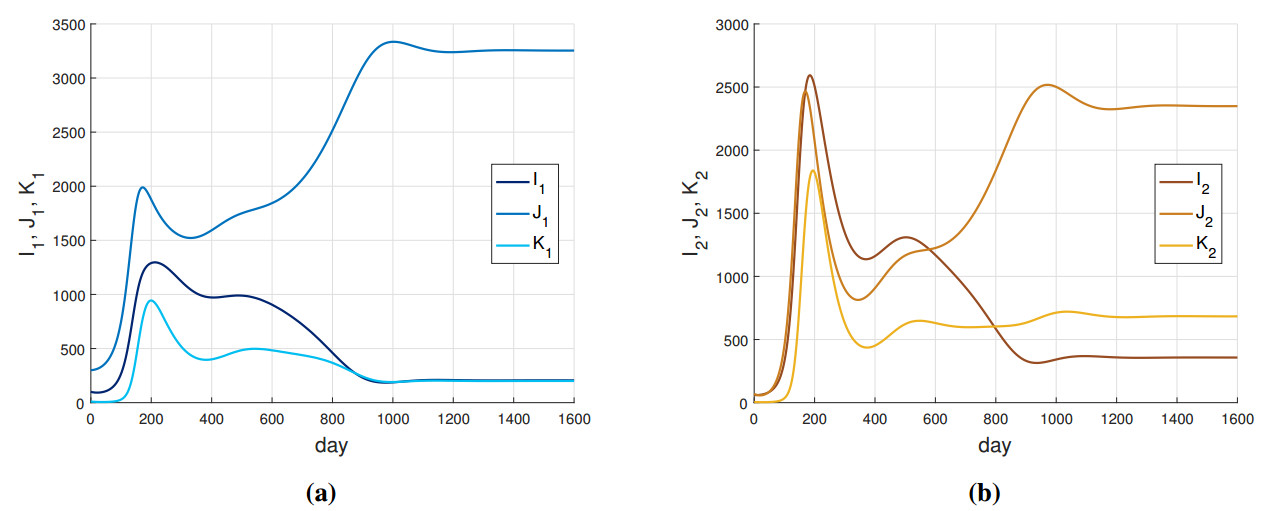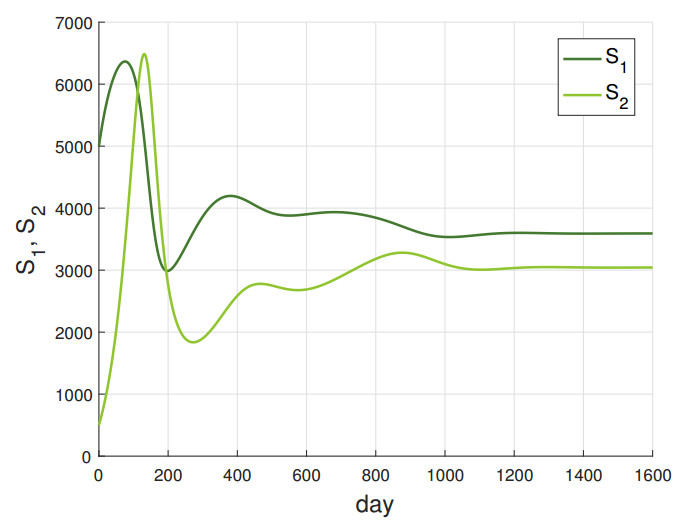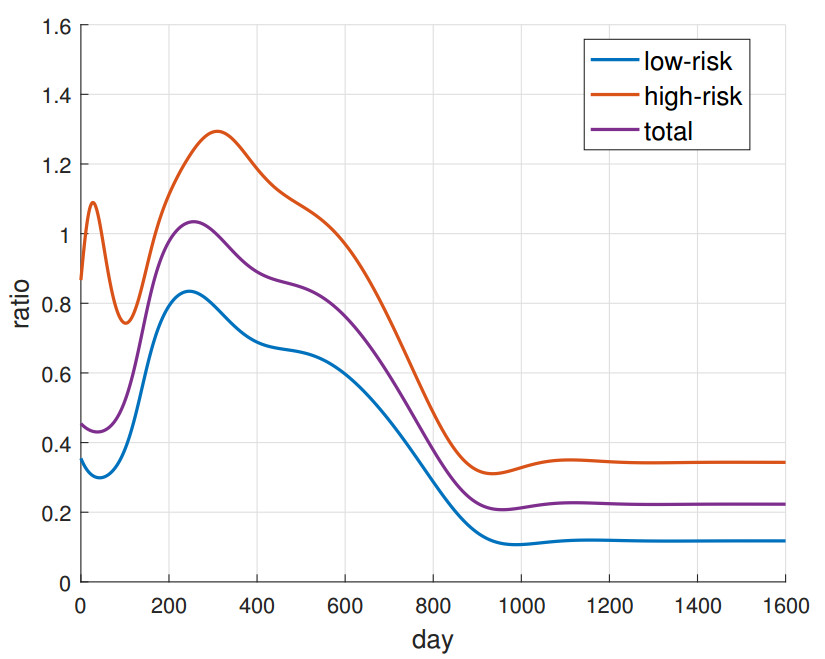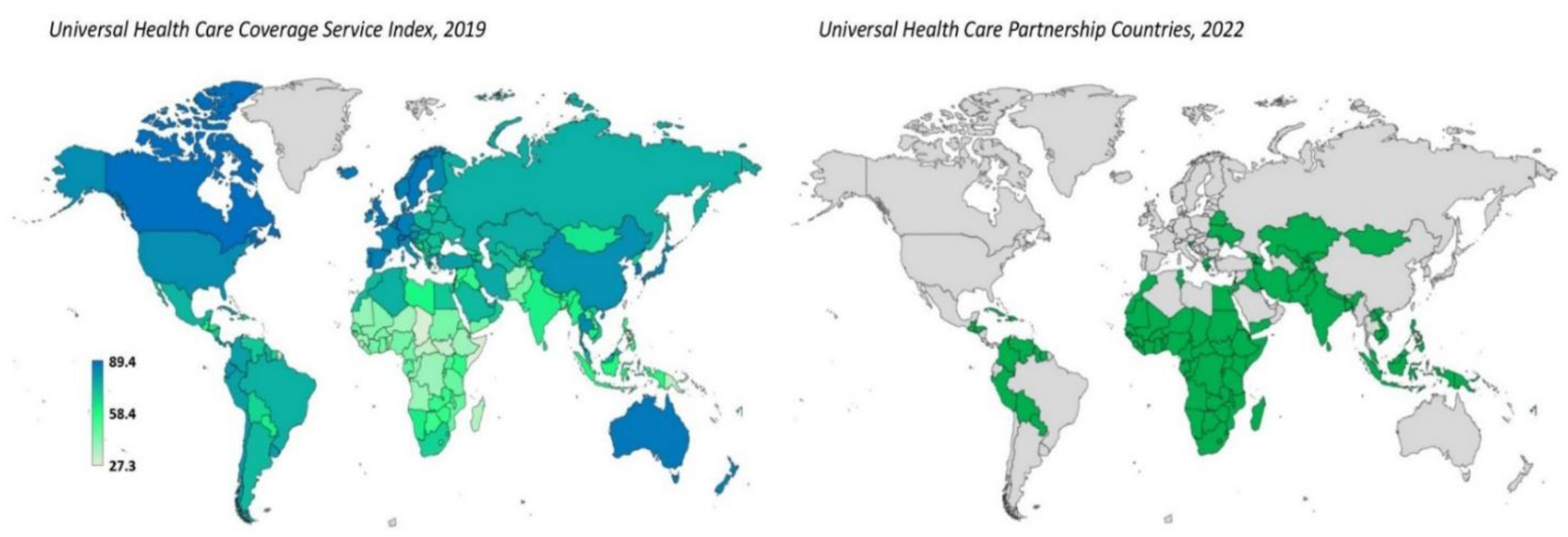1.
Introduction
There is a large number of papers with mathematical models of epidemic dynamics. These papers relate to both homogeneous and heterogeneous populations. By heterogeneous population we understand a population with at least two subpopulations that differ in the risk of getting infected. Because of convenience and lack of appropriate data, only two subpopulations are often distinguished. In recent papers [1] and [2], one can find exemplary models of epidemic spread in such populations with mathematical analysis.
Nowadays, the risk of co-infections is increasing worldwide, including co-infections with COVID-19 [3]. This increase is caused by, for example, increased people's mobility [4], drug resistance [5], impaired immunity after suffering from long COVID-19, and reduction of exposure to microbiota caused by home isolation during the COVID-19 pandemic [6]. Also, getting an infection raises the probability of simultaneous development of another illness [7]. Co-infection also boosts healthcare costs [8] and number of deaths [9]. It is therefore essential to put an effort into reducing co-infection cases. This reduction can be achieved by applying mathematical modeling. Thanks to mathematical models of co-infection spreading and their mathematical analysis, one can predict co-infections and implement proper therapeutic approaches. This is desirable since data concerning co-infections are less accessible than for single epidemics.
Generally, models of co-infection dynamics are based on models that describe the spread of a single epidemic. Hence, they have a more complex form and are, consequently, more difficult to analyze. However, one can find literature dealing with mathematical analysis of co-infection spread. A recent paper [10] conducted a systemic review of mathematical models. A model of general co-infection for an acute and a chronic disease was presented in [11]. The authors in [12] proposed and analyzed the model of COVID-19 and tuberculosis (TB) infection. The same type of epidemics, together with measuring impact on isolation, was investigated in [13]. Papers [14] and [15] provide mathematical models for the spread of SARS-CoV-2 with hepatitis B virus and SARS-CoV-2 with human T-cell lymphotropic virus type-I, respectively. The analysis of models concerning individuals suffering from COVID-19 and kidney disease was presented in a recent work [16]. An interesting approach is presented in [17], where the authors investigated the co-infection of airborne and vector-host diseases, namely COVID-19 and dengue.
Not only COVID-19 is investigated in co-infection modeling. Since HIV infection increases the probability of developing TB [18], papers related to the modeling of TB and HIV spread contribute significantly to the literature. Authors in [19] distinguish two TB infected classes: fast and slow latent. They also considered acute and chronic HIV-infected groups. A recent paper [20] focused on an analysis of a TB/HIV epidemic spread in Ethiopia, with two infected groups for each disease. Naturally, other co-infections are also analyzed in the literature. Authors in [21] investigated the epidemic of HIV and hepatitis C virus, whereas paper [22] dealt with co-infection of TB and pneumonia.
In each paper described above, authors assumed that there is only one class of people that are not infected with any disease; this means they are susceptible to both infections. This leads to situations where the probability of co-infection is raised only by encountering a single infection. That supposition implies no population heterogeneity for healthy individuals. Clearly, this case is not valid. Therefore, there is a need to include heterogeneity in a susceptible class. While modeling an epidemic of a single infection for a heterogeneous population, authors assume that values of parameters reflecting a given subpopulation are the same. This assumption actually leads to the case of a homogeneous population. To adequately describe the dynamics of infection, and consequently of co-infection, in a heterogeneous population, one must consider different values of parameters for each subpopulation. Such consideration makes the mathematical analysis of the model more difficult; thus, this approach is uncommon.
Our paper aims to construct and analyze the mathematical models of co-infection in a heterogeneous population consisting of two subpopulations. We assume that parameter values reflecting a given process in each subpopulation differ. This assumption and the heterogeneity in the population make our paper novel among the literature considering the modeling of co-infections. In our model, we also introduce a case of a spread of each disease not only among one subpopulation but also between subpopulations. This introduction enables our system to be classified as a criss-cross model. We propose a system of ordinary differential equations that is a SIS-type (susceptible – infected – susceptible) model. In models of such type, there is no immunity after recovery and an individual becomes susceptible again. Including heterogeneity constrains computations. For this reason, we do not incorporate a recovered class to maintain explicit results of the analysis. Our model does not relate to particular diseases. Hence, one can apply the obtained results to different infections. Such applications include co-infections that combine sole airborne illnesses, such as TB, COVID-19, or influenza, sexually transmitted diseases, such as gonorrhea, HIV, and hepatitis B, or incorporate illnesses from both types.
This paper is a continuation of our work from [23] and [24], in which we investigated the criss-cross model of epidemic spread of a single disease for a heterogeneous population. In [23], we conducted the mathematical analysis of the model that was proposed in [25]. The aim of that analysis was to confirm, from a mathematical point of view, the medical hypothesis that stated that to control the epidemic spread in the heterogeneous population, one must consider criss-cross illness transmission. Investigating such spread in a single subpopulation does not provide complete insight into the epidemic dynamics. Because of the proposed model's unexpected properties, such as a possible unbounded population growth, we modified the system from [23] by assuming a constant inflow into each subpopulation. We analyzed that modified system in [24] and again obtained consistency with the medical hypothesis. Considering that the second disease in epidemic dynamics for a heterogeneous population is medically driven by an increasing number of co-infections worldwide and different scenarios regarding individuals' susceptibility can provide mathematical results that can help predict a co-infection course.
In [23] and [24], we focused on the stability analysis; we indicated stationary states appearing in the given systems and determined the conditions for their local stability. In this paper, we also apply this approach. The model presented herein relies on the system from [24].
The paper is organized as follows: In Section 2, we describe and introduce our model. Then we find stationary states of the system and describe conditions for their existence. The basic reproduction number of the model is computed in Section 4. The following section deals with local stability of the found stationary state. We summarize our results in Section 7.
2.
Formulation of a model and its basic properties
Let us first describe the assumptions concerning the proposed model. In a population, we indicate two subpopulations, a low-risk (LS) and a high-risk (HS) subpopulation, relating to the risk of getting infected. LS and HS have, respectively, lower and higher susceptibility to each disease. For every variable and parameter, we assign a subscript i equal to 1 and 2 for LS and HS respectively. If i has no assigned value, then i∈{1,2}. By S1 and S2, we denote a density of healthy people in LS and HS, respectively. The variables Ii refer to the density of individuals from the given subpopulation that are infected by a pathogen of the disease that we call disease A (DA). Similarly, we define Ji as the density of individuals suffering from disease B (DB). The density of a group infected by pathogens from both diseases is denoted by Ki.
Migrating and newborn individuals join each subpopulation through Si class with a recruitment rate Ci. A natural death rate for each subpopulation is equal to μi. For DA, we introduce the transmission rates β11, β22, β12 and β21, reflecting transmission among LS, among HS, from HS to LS, and from LS to HS, respectively. These four different rates mean that DA differs in spreading and contracting a pathogen. To get a preliminary insight on co-infection dynamics for the heterogeneous population, for DB we assume that individuals differ only in contracting a pathogen. For this reason, we take only two transmission coefficients for DB: σ1 for LS and σ2 for HS. By γi and gi, we denote the recovery rate for DA and DB, respectively. The disease-mortality rate for DA and DB is depicted by αi and ai.
The proposed model of co-infection is
Each parameter is fixed and positive. In particular, every parameter besides Ci is in the range (0,1). If we assume that σi,gi,ai=0, the above system would reduce to the system that we introduced and analyzed in [24].
Figure 1 is a schematic drawing of the proposed model.
In order to make the form of system (2.1) more transparent, we define:
Now we indicate the basic properties of the model. The form of the right-hand side of system (2.1) implies that its solutions exist and are unique and positive for any positive initial condition. Let us introduce a variable Ni:=Si+Ii+Ji+Ki that naturally means a density of the whole HS or LS. After adding both sides of Eqs (2.1a)–(2.1d) or Eqs (2.1e)–(2.1h), we get
See that we can estimate Eq (2.3) from above by the inequality
which solution is
For Ni(0)>Ciμi, we observe a decrease of the population. Clearly, we have
For Ni(0)<Ciμi, we have a limited growth of the population, since
where ˜C is any positive constant.
Now we estimate Eq (2.3) by
Combining inequalities (2.4) and (2.5), we get
which produces the invariant set
This set attracts all solutions of system (2.1). We therefore conclude that the variables Si(t), Ii(t), Ji(t), and Ki(t) are defined for every t>0.
3.
Stationary states
In this section, we indicate stationary states of system (2.1) and determine conditions for their existence.
3.1. Non-endemic stationary states
Firstly, we find stationary states that are not endemic, meaning that at least one of their coordinates equals zero.
We consider separated cases.
1) Firstly, let us assume that Ii=Ji=Ki=0. We immediately get the form of the disease-free stationary state:
Clearly, this state always exists.
2) Now, consider the case Ki=0. Without loss of generality, we take K1=0. From Eq (2.1d) for any stationary, state we have 0=σ1I1(J1+J2)+β11J1I1+β12J1I2, which implies
Let us consider the first alternative from (3.2).
a) We first take I1=0. From Eq (2.1b), we have β12S1I2=0, which yields S1=0 or I2=0. If S1=0, then Eq (2.1b) gives the contradiction 0=C1+g1J1. If I2=0, then from Eq (2.1h) we have K2=0 and our system reduces to:
The above system's form suggests that there is a stationary state with present DB and absent DA. We will investigate the existence of such postulated state later. System (3.3) fulfills the case I1=0∧I1=0∧I2=0 from (3.2).
Now, assume that I1=0∧J1=0∧J1=0 holds. Then from Eq (2.1b), we get β11S1I2+g1K1=0. It provides S1=0 or I2=0. Case S1=0 linked to Eq (2.1a) yields the contrary, 0=C1, hence we must have I2=0. Then from Eqs (2.1c) and (2.1h), we get J2=0 and K2=0, respectively. We obtain state Edf.
It is easy to check that the case I1=0∧J1=0∧I2=0 gives Edf as well. The case I1=0∧I1=0∧J1=0 is equivalent to I1=0∧J1=0∧J1=0.
b) Now assume that J1+J2=0. This assumption obviously provides J1=0 and J2=0. From Eq (2.1g), we get ˙J2=γ2K2, giving K2=0. We obtain the system
where j=3−i. The above system fulfills condition J1+J2=0∧J1=0∧J1=0, emerged from (3.2).
If we take J1+J2=0 and simultaneously one of the cases J1=0∧I2=0, I1=0∧J1=0 or I1=0∧I2=0, then we obtain Edf.
3) Now suppose that I1=0. From Eq (2.1b), we get 0=β12S1I2+g1K1. From S1I2=0, we get I2=0, which gives system (3.3). Choosing K1=0 leads to system (3.4).
4) Consider J1=0. Then Eq (2.1c) yields 0=σ1S1J2+γ1K1. Both cases J2=0 and K1=0 provide system (3.4).
5) Assuming I1=0∧J1=0 leads to state Edf.
6) Supposing I1=0∧K1=0 and J1=0∧K1=0 results in systems (3.3) and (3.4), respectively.
Reasoning from points 1)–6) conducted for the variables with subscript 2 gives the same conclusions.
System (3.4) appears in our previous paper [24]. The solution of this system provides the endemic state E∗=(S∗1,I∗1,S∗2,I∗2). This state is the projection of the state
onto the non-negative subspace (S1,I1,S2,I2)∈R4. State EA reflects the presence of DA and the absence of DB. Observe that adding both sides of Eqs (2.1a)–(2.1b) and Eqs (2.1e)–(2.1f) for EA yields 0=Ci−μi(Ii+Si)−αiIi, providing
Relying on results for state E∗ from [24], we formulate conditions for the existence of state EA.
Proposition 1. In System (2.1), there exists the stationary state EA defined in (3.5) that reflects the presence of disease A and the absence of disease B. This state exists if at least one of three cases holds:
1) β11C1≥μ1k1;
2) β22C2≥μ2k2;
3) βiiCi<μiki and
For EA, we have
Now we focus on system (3.3). Equation (2.3), being the sum of equations from this system, simplifies to ˙Ni=0=Ci−μiSi−(μi+ai)Ji, which gives
Computations concerning this system indicate the expected stationary state. Observe that the structure of system (3.3) is analogous to the structure of system (3.4). Based on this analogousness and Proposition 1, we formulate the following proposition concerning the other stationary state.
Proposition 2. In System (2.1), there exists the stationary state
with present disease B and absent disease A. This state exists if at least one of three cases holds:
1) σ1C1≥μ1q1;
2) σ2C2≥μ2q2;
3) σiCi<μiqi and
For EB, we have
3.2. The existence of the endemic stationary state
Now we investigate the endemic stationary state, reflecting the presence of both diseases A and B. Since it is difficult to obtain its explicit form, we limit our investigation to indicate some properties concerning its existence. Let us define Zi:=Ii+JI+Ki. Obviously, variable Zi is the density of individuals from the particular subpopulation infected by disease A, B, or both. Summing both sides of Eqs (2.1b)–(2.1d) gives
From the above equation for the postulated endemic state, we have
Equation (2.3) and definition of N1 for this state yield
Since S1>0, one must fulfill
Combining reorganized Eqs (3.12) and (3.11), we get
where s1:=α1+a1+μ1 and w1:=g1+a1+μ1.
From Eqs (2.1a)–(2.1d), we get the formula for coordinates S1,I1,J1,K1:
Positivity of coordinates I1 and J1 yields inequalities:
Combining the above dependences with condition (3.14a), we get
If we substitute Eq (3.14d) into the above inequality, we get
Observe that the reasoning presented in this subsection can be applied to variables with subscript 2. This application provides another condition for the existence of the postulated endemic state.
4.
The basic reproduction number
In this section, we find and investigate the basic reproduction number R0 of system (2.1). According to the definition from [26], R0 refers to the number of new infections produced by a single infectious individual in a population at a disease-free stationary state. To compute R0, we will rely on the next generation method described in [26]. In this section, we provide a sketch of computations leading to the formula for R0. We consider the subsystem of system (2.1), including the equations only for infected variables:
where vector F concerns the terms related to new infections, and vector V reflects the remaining processes. These vectors read
respectively. We construct matrices F and V that are the Jacobian matrices of F and V evaluated at Edf. These matrices have the form
Then we compute FV−1 and obtain
The basic reproduction number is the spectral radius of the matrix FV−1. The eigenvalues of this read λ1,2,3=0,λ4=σ1q1ˆS1+σ2q2ˆS2, and
We finally get
See that λ4 consists of terms relying to only infection B, whereas λ6 refers only to infection A.
Now we formulate the theorem relied on the dependence between λ4 and λ6.
Theorem 4.1. R0=λ4 if
where
and
Proof. Observe that λ4>λ6 if
Under fulfillment of
we raise both sides of inequality (4.4) to the square and transform the result to
Using the definition of λ4 in the above inequality and transforming the obtained expression, we get
where ui is defined by Eq (4.2). We rewrite inequality (4.6) as inequality (4.1). Inequality (4.5) with the definition of λ4 can be transformed into inequality (4.3). □
Let us strengthen the assumptions from Theorem 4.1 so that we obtain more explicit ones. Suppose that ui>0, which can be written as
Then condition
suffices fulfillment of inequality (4.1). Moreover, if
then inequality (4.3) is always true. Combining inequalities (4.7) and (4.9) yields
We conclude that
Corollary 1. If inequality (4.10), then R0=λ4.
The above corollary confirms the obvious dependence that if the transmission of infection B, represented by σi, is sufficiently stronger than the transmission of infection A between different subpopulations, reflected by βii, then infection B plays a bigger role in the whole population.
Observe that if in inequality (4.3) we replace sign > by sign <, then λ4<λ6. It yields R0=λ6, which is the same as R0 for the system with one infection from [24].
From a medical point of view, the desirable situation is when R0<1. Let us check when this case holds. We formulate the theorem
Theorem 4.2. For system (2.1) R0<1 if
and
Proof. Condition (4.11) is obvious from the definition of λ4. The part of the proof related to λ6 is similar to the proof of Theorem 4.1. The inequality λ6<1 can be transformed into
Under condition
multiplying both sides of inequality (4.14) yields
which can be written as inequality (4.13). The right-hand side of inequality (4.13) must be positive. It is true when ˆSi>kiβii or (4.12). The first case is contrary to inequality (4.15). Hence, inequality (4.12) must hold, which is stronger than inequality (4.15). □
If is easy to check that inequality (4.13) is opposite to inequality (3.7) from Preposition 1 discussing the existence of state EA. Similarly, inequality (4.11) is opposite to inequality (3.10) from Preposition 2 providing conditions for the EB existence.
5.
Local stability of stationary states
Now we investigate the local stability of states Edf, EA, and EB. The Jacobian matrix of system (2.1) can be written as J=(M1M2), where
and
with
We start from the local stability of Edf.
Theorem 5.1. Edf is locally stable if R0<1.
Proof. The Jacobian matrix for state Edf reads
Immediately, we get four negative eigenvalues: −μ1, −μ2, −r1, −r2. The remaining eigenvalues are the zeros of the characteristic polynomial of the matrix:
This polynomial reads P(λ)=P1(λ)P2(λ), where
It is easy to check that their discriminants are positive. The zeros of P1 are negative if inequalities (4.12) and (4.13) hold. Analogously, P2 has negative zeros if
and
Inequality (5.2) can be transformed into inequality (4.11). According to Theorem 4.2, merging inequality (4.11)–(4.13) yields R0<1. Inequality (5.2) yields two exclusive possibilities: σiˆSi>qi or
The first case is contrary to inequality (5.1), whereas inequality (5.3), under condition (5.2), yields inequality (5.1). Hence, we replace inequality (5.1) by inequality (5.3). We rewrite inequality (5.3) as
Observe that the above inequality is weaker than inequality (4.11); hence, it is omitted in the thesis of Theorem 5.1. □
Theorem 5.1 is in line with the analogical result from [24], where we also obtained the local stability of the given disease-free stationary for the basic reproduction number smaller than one.
5.1. Local stability of EA
Now we provide a theorem guaranteeing the local stability of state EA.
Theorem 5.2. EA is locally stable if
and
Proof. Let us rearrange matrix J(EA) so that the characteristic polynomial of the new matrix remains the same. We get M∗=(M∗1 M∗20M∗3), where
and
The form of M∗2∈M4(R) is not needed for further computations.
We start by investigating matrix M∗1. To simplify computations, we define auxiliary notations:
Thanks to this simplification, matrix M∗1 reads
The characteristic polynomial of M∗1 has the form
where
Observe that if
and
then each coefficient of P1 is positive. Hence, from Descartes' rule of signs, we get that P4 has real negative roots or complex roots with negative real parts. Substituting definition (5.11) into inequalities (5.12) and (5.13) provides inequalities (5.4) and (5.5), respectively.
Let us focus now on matrix M∗3. After using notations:
we rewrite M∗3 as
The characteristic polynomial of the matrix reads P3(λ):=λ4+c3λ3+c2λ2+c1λ+c0, where
Let us investigate the signs of the coefficients of polynomial P3. Observe that if inequality (5.6) holds, then t1,t2>0, which yields c3>0. Conditions r1r2>s1s2 and riti>γiai, which can be written as inequalities (5.7) and (5.8), respectively, yield c2>0. See that c1>0 if (ti+ri)(tjrj−γjaj)>si(rjsj+γjyj) for j=3−i, which we transform to
Using expressions from (5.14), we rewrite the above inequality as inequality (5.9). Condition c0>0 can be written as
With (5.14), the above inequality transforms into inequality (5.10). □
Now let us strengthen conditions from Theorem 5.2 providing the local stability of EA so that they have a more explicit form. Observe that the condition
yields fulfillment of inequality (5.6). Moreover, from definitions (2.2), clearly we have ri>qi. Hence, inequality (5.16) implies inequality (5.7).
Again relying on (2.2), we get ri>γi. Instead of inequality (5.8), it is therefore enough to investigate the inequality
If inequality (5.16) holds, then the left-hand side of the above inequality is always positive. Using Eq (3.6), we transform this inequality into
From the definition of ri, the denominator of the right-hand side of inequality (5.17) is positive if
which is always true. The positivity of the numerator of the right-hand side of inequality (5.17) is maintained if
Now observe that since ri>γi, inequality (5.9) can be, under fulfillment of inequality (5.16), strengthened to
If inequality (5.16) holds, then one must fulfill
so that inequality (5.19) makes sense. Using Eq (3.6), we transform inequality (5.20) into
which is reasonable if
Observe that inequality (5.22) is stricter than inequality (5.18). Rewriting inequality (5.19), we get
Using again Eq (3.6), we transform the above inequality into
Now we use the dependence ri>γi and transform inequality (5.10) into
which can be simplified to
Clearly, inequality (5.24) is stricter than inequalities (5.16) and (5.21).
Using Eq (3.6), we rewrite inequality (5.24) as
We finally conclude that
Corollary 2. If (5.4), (5.5), (5.17), (5.22), (5.23) and (5.25), then EA is locally stable.
Let us treat the left-hand side of inequality (5.23) as a quadratic trinomial P(S∗j). If inequality (5.22) holds, then the condition Ci>σiS∗i suffices for the constant of P(S∗j) to be positive. Hence, the form of P(S∗j) implies that inequality (5.23) is true for 0<S∗j<S, where S is the positive zero of P(S∗j).
5.2. Local stability of EB
Now we provide the theorem indicating the conditions for the local stability of state EB:
Theorem 5.3. EB is locally stable if
Proof. Similarly as in the proof of Theorem 5.2, we transform matrix J(EB) into MB=(ˉM1ˉM20ˉM3), where
We start from matrix ˉM1. After using notations:
we transform ˉM1 to
The characteristic polynomial of matrix ˉM1 reads P1(λ)=λ4+c3λ3+c2λ2+c1λ+c0, where
Observe that if
and
then c2,c1,c0>0. Hence, from Descartes' rule of signs, we get that P1 has real negative roots or complex roots with negative real parts.
Using definitions (5.31), we rewrite inequality (5.32) as inequality (5.6) and inequality (5.33) as
Now we focus on matrix ˉM3. With the use of expressions,
we rewrite ˉM3 as
which has a similar form as matrix M∗3 from (5.15). This similarity allows us to apply reasoning for M∗3 to ˉM3. Analogically to conditions (5.6)–(5.10), we obtain inequalities (5.26)–(5.30). □
Similarly as for Theorem 5.2, let us strengthen conditions from Theorem 5.3 providing the local stability of EB. Since ri>gi, we replace inequality (5.28) by
which obviously requires fulfillment of inequality (5.26). Using Eq (3.8), we express the above inequality as
under fulfillment of
Again using the dependence ri>gi, we simplify inequality (5.29) to
Since inequality (5.26) holds, it is enough that inequality (5.36) holds so that inequality (5.39) makes sense.
Inequality (5.30) can be strengthened by
which can be expressed as
The above inequality is always true if
and
Using Eq (3.8), we rewrite inequality (5.42) as
Let us compare inequalities (5.26) and (5.27). Observe that ri>ki. Moreover, if inequality (5.41) holds, then inequality (5.26) is stronger than inequality (5.27).
Finally, we conclude that
Corollary 3. If inequalities (5.26), (5.37), (5.38), (5.39), (5.40), (5.41), and (5.43) hold, then EB is locally stable.
6.
Postulated local stability of the endemic state: numerical simulation
In Subsection 3.2, we provided only a slight analysis of the existence of the endemic stationary state EE, with two diseases present. We are therefore not certain if this state exists. Furthermore, the complexity of the proper Jacobian matrix does not allow us to obtain the explicit conditions for local stability of such a postulated equilibrium. However, the conditions from Theorems 5.2 and 5.3 restrict a set of parameters' values guaranteeing the local stability of existing states EA and EB. Such restriction suggests that there should be ranges of the values for the EE local stability under its existence. Indicating these ranges is difficult, even numerically, because of the system's intricacy. For this reason, for each parameter, we only give specific values that yield the desirable local stability. We rely on the values from [10] that concern TB and COVID-19. In our system, these diseases correspond to diseases A and B, respectively. Since paper [10] relates to co-infection dynamics in a homogeneous population, we arbitrarily choose the values of incompatible parameters from our system. These values are chosen so that we reach the EE local stability. In Table 1, one can find the taken numbers.
We illustrate the local stability of EE on the plots showing the dependence of the system's solution on time for each particular variable. For the illustration, we use the Matlab software, which provides a built-in ode45 function. This function numerically solves a given differential equation system for a specified initial condition [27]. For the simulation, we take the parameters' values from Table 1 and the arbitrarily chosen initial condition
Figures 2–3 depict the result of the simulation. For the figures' transparency, we show plots for the infected variables for each subpopulation and the non-infected variables in separate picture graphs. The obtained figures suggest the existence of the stationary state Ee that is locally stable for the parameter values from Table 1.
Now for the illustrated example of epidemic, we depict the relative sizes of the infections for time t that we define by ratios:
These ratios correspond to LS, HS, and the whole population, respectively, and in our case represent the number of TB-infected individuals relative to the number of COVID-infected ones. Figure 4 shows the dependence of the relative sizes on time.
For the last point of the simulation timescale, i.e., ˉt=1600, we get R1(ˉt)=0.1176 and R2(ˉt)=0.3432. Plots from the figure suggest the convergence of each relative size. We therefore state that for the stabilized co-infection epidemic, for one TB-infected person, there are approximately nine and three COVID-infected people in LS and HS, respectively.
7.
Conclusions
In this paper, we proposed and analyzed the continuous-time model (2.1) describing co-infection in a heterogeneous population, in which we distinguish two subpopulations. These subpopulations, low-risk LS and high-risk HS, differ in the risk of getting infected by any of two diseases, called disease A (DA) and disease B (DA). The values of the parameters for every subpopulation are different, which guarantees complete population heterogeneity. System (2.1) has three stationary states: disease-free (Edf), with sole DA or DB (EA and EB). We also suspect that the endemic state, with two diseases present, exists, but we did not manage to prove it because of complicated computations. State Edf exists unconditionally, while provided conditions determine the existence of EA and EB. For state Ee, we only gave insight into its existence because of the complexity of the computations. For system (2.1), we computed the basic reproduction number R0. This number is the maximum of two terms, whose forms depend on parameters corresponding to the particular sole infection. Later, we investigated the local stability of the stationary state. State Edf is locally stable if R0<1, which is expected. Analysis of the local stability for EA and EB provided the list of conditions. Importantly, the parameters from both diseases affect the local stability of both states.
The proposed model expands the system from [24], where we investigated the epidemic dynamics of one disease in heterogeneous populations. In that system, there are only two stationary states: the disease-free state and the endemic state, which is a counterpart of state EA of system (2.1). The results for their local stabilities are analogical to those for state Edf and EA in this paper.
The next step of our work will be an analysis of the proposed model with some assumptions simplifying this form. We hope to obtain the endemic state of the simplified model and get explicit results concerning its local stability.
Use of AI tools declaration
The authors declare they have not used Artificial Intelligence (AI) tools in the creation of this article.
Conflict of interest
The author declares there is no conflict of interest.
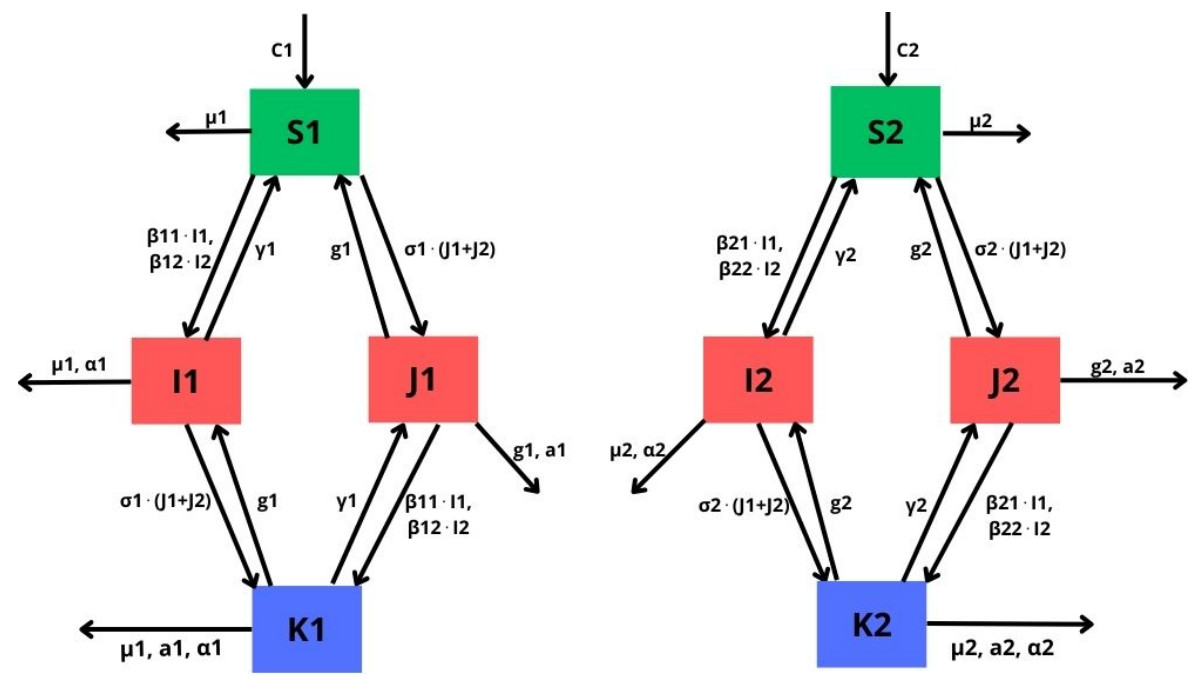









 DownLoad:
DownLoad:
